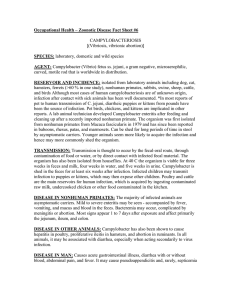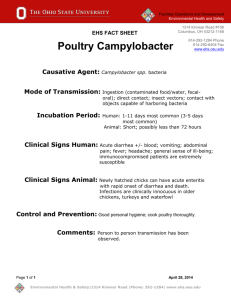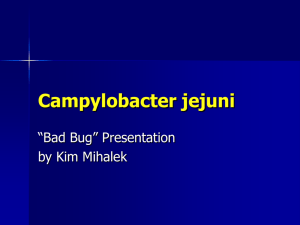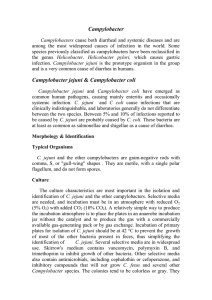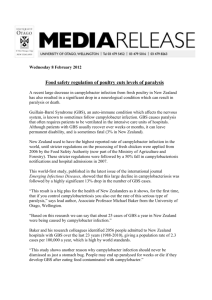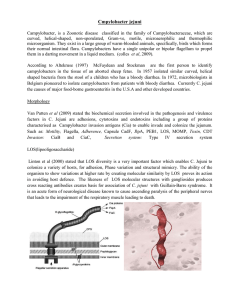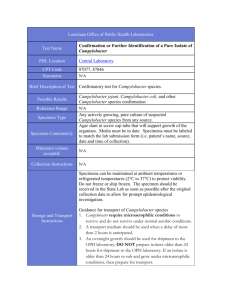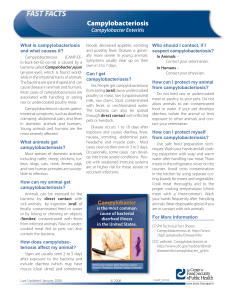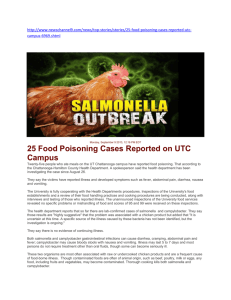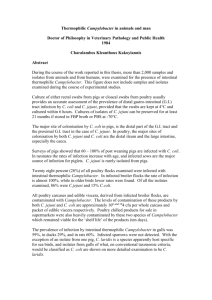Control of Campylobacteriosis in chicken
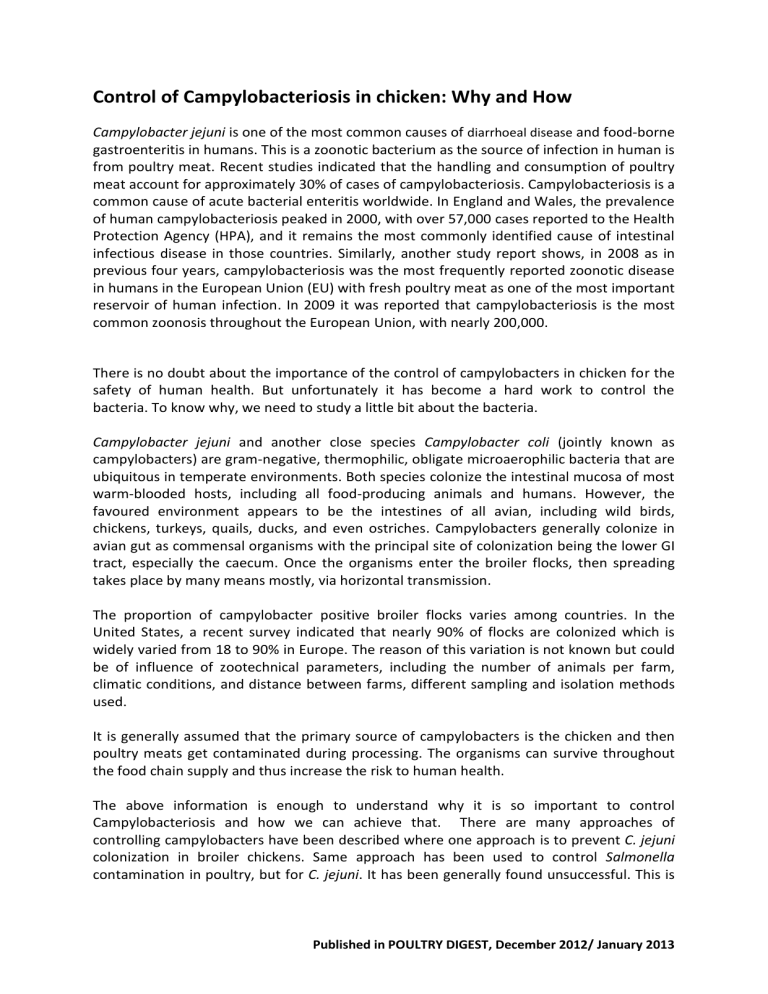
Control of Campylobacteriosis in chicken: Why and How
Campylobacter jejuni is one of the most common causes of diarrhoeal disease and food-borne gastroenteritis in humans. This is a zoonotic bacterium as the source of infection in human is from poultry meat. Recent studies indicated that the handling and consumption of poultry meat account for approximately 30% of cases of campylobacteriosis. Campylobacteriosis is a common cause of acute bacterial enteritis worldwide. In England and Wales, the prevalence of human campylobacteriosis peaked in 2000, with over 57,000 cases reported to the Health
Protection Agency (HPA), and it remains the most commonly identified cause of intestinal infectious disease in those countries. Similarly, another study report shows, in 2008 as in previous four years, campylobacteriosis was the most frequently reported zoonotic disease in humans in the European Union (EU) with fresh poultry meat as one of the most important reservoir of human infection. In 2009 it was reported that campylobacteriosis is the most common zoonosis throughout the European Union, with nearly 200,000.
There is no doubt about the importance of the control of campylobacters in chicken for the safety of human health. But unfortunately it has become a hard work to control the bacteria. To know why, we need to study a little bit about the bacteria.
Campylobacter jejuni and another close species Campylobacter coli (jointly known as campylobacters) are gram-negative, thermophilic, obligate microaerophilic bacteria that are ubiquitous in temperate environments. Both species colonize the intestinal mucosa of most warm-blooded hosts, including all food-producing animals and humans. However, the favoured environment appears to be the intestines of all avian, including wild birds, chickens, turkeys, quails, ducks, and even ostriches. Campylobacters generally colonize in avian gut as commensal organisms with the principal site of colonization being the lower GI tract, especially the caecum. Once the organisms enter the broiler flocks, then spreading takes place by many means mostly, via horizontal transmission.
The proportion of campylobacter positive broiler flocks varies among countries. In the
United States, a recent survey indicated that nearly 90% of flocks are colonized which is widely varied from 18 to 90% in Europe. The reason of this variation is not known but could be of influence of zootechnical parameters, including the number of animals per farm, climatic conditions, and distance between farms, different sampling and isolation methods used.
It is generally assumed that the primary source of campylobacters is the chicken and then poultry meats get contaminated during processing. The organisms can survive throughout the food chain supply and thus increase the risk to human health.
The above information is enough to understand why it is so important to control
Campylobacteriosis and how we can achieve that. There are many approaches of controlling campylobacters have been described where one approach is to prevent C. jejuni colonization in broiler chickens. Same approach has been used to control Salmonella contamination in poultry, but for C. jejuni. It has been generally found unsuccessful. This is
Published in POULTRY DIGEST, December 2012/ January 2013
considered a reflection of differences in the physiology, epidemiology, and ecology of these organisms.
The high number of campylobacteriosis cases in Europe, prompted several researchers in identifying campylobacter control strategies in poultry. Several studies have been completed to find out effective control and preventive measures. Researchers agree on this comment that the reduction and/or elimination of C. jejuni in the food chain, particularly from chicken products, are a major strategy in efforts to control this disease. But reduction of campylobacter prevalence and load in live poultry is believed to be one of the most effective ways of reducing the contamination. Current pre-harvest strategies to reduce campylobacter include on-farm biosecurity measures, the decontamination of litter, and the supplementation of feed with compounds inhibiting campylobacter and the treatment of drinking water. Moreover, novel strategies, specifically targeting campylobacter control at farm level are administration of organic acids, probiotics, vaccination, antibiotics in combination with bacteriophages, bacteriocins.
Trials have been conducted to test organic acids as additives in drinking water and feed for the reduction of Campylobacters and Salmonella in chickens. Results have shown that organic acids in feed and/or drinking water have the potential of reducing the
Campylobacters load in chicken caecum and thus reducing carcass contamination during slaughter. So organic acids in feed and/or drinking water in broiler flocks could play a crucial role in reduction of Campylobacters in chickens and thus eliminate the potential risk of human campylobacteriosis.
References:
B. Skanseng, M. Kaldhusdal, B. Moen, A.-G. Gjevre, G.S. Johannessen, M. Sekelja, P. Trosvik and K. Rudi (2010). Prevention of intestinal Campylobacter jejuni colonization in broilers by combinations of in-feed organic acids. Journal of Applied Microbiology 109. 1265–1273
D. G. Newell and C. Fearnley (2003). Sources of Campylobacter Colonization in Broiler
Chickens. Appl. Environ. Microbiol. 2003, 69(8):4343 - 4351.
D. G. Newell, K. T. Elvers, D. Dopfer, I. Hansson, P. Jones, S. James, J. Gittins,7 N. J. Stern,
R. Davies, I. Connerton, D. Pearson, G. Salvat, and V. M. Allen (2011). Biosecurity-Based
Interventions and Strategies To Reduce Campylobacter spp. on Poultry Farms. Applied and
Environmental Microbiology, p. 8605–8614 Vol. 77, No. 24
F. PASQUALI, A. DE CESARE, G. MANFREDA and a. FRANCHINI (2011). Campylobacter control strategies in European poultry production. World's Poultry Science Journal Vol 67 Issue 01, pp 5 18
Van Immerseel, F., Russell, J.B., Flythe, M.D., Gantois, I.,Timbermont, L., Pasmans, F.,
Haesebrouck, F. andDucatelle, R. (2006). The use of organic acids to combat Salmonella in poultry: a mechanistic explanation of the efficacy. Avian Pathology. 35, 182–188
Published in POULTRY DIGEST, December 2012/ January 2013
